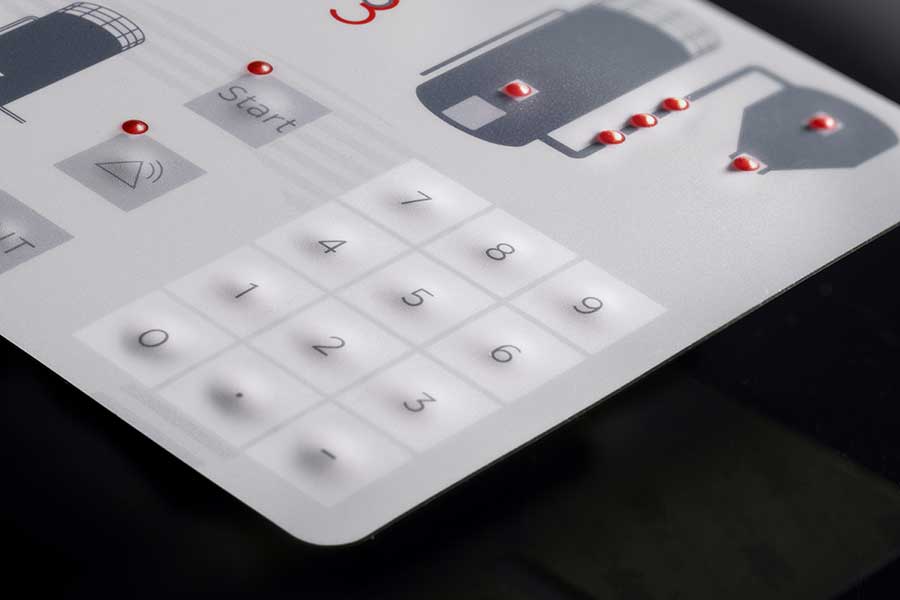Exactly How Membrane Changes Add To the Durability of Electronic Control Panels
Membrane buttons play a crucial role in enhancing the toughness of digital control panels, largely via their multi-layered building and construction which gives reliable defense versus environmental variables such as dampness and dust. The absence of relocating parts significantly lowers the probability of mechanical failings, making membrane layer switches perfect for demanding applications.
Interpretation of Membrane Layer Buttons

Membrane layer buttons are made to be thin and lightweight, making them appropriate for applications where space is limited. They can be produced in different shapes, sizes, and shades, using versatility in layout that satisfies aesthetic and useful needs. Furthermore, membrane switches can integrate different modern technologies, such as tactile responses and LED indicators, enhancing user experience.
Due to their construction, membrane switches are frequently resistant to dust, dampness, and basic wear, adding to their sturdiness sought after environments. Their smooth layout not just helps with simple cleaning however also minimizes the danger of mechanical failure, making them a recommended selection for producers looking for reputable customer interfaces in their digital control panels.
Protection Against Ecological Aspects
The style of membrane switches naturally provides a level of security versus various environmental elements, which is essential for keeping functionality in challenging problems - Membrane Switch. These switches are normally built with layers of flexible products that shield inner elements from moisture, dirt, and pollutants. By enveloping the wiring, membrane changes decrease the danger of brief circuits and deterioration, which can significantly harm efficiency
Furthermore, making use of durable adhesives and sealants throughout production improves their resistance to ecological obstacles. Membrane buttons can sustain exposure to chemicals and solvents, making them ideal for markets such as food processing and health care, where health and sanitation are critical. Their seamless surface layout additionally prevents the build-up of dust and germs, facilitating simpler cleaning and upkeep.
Temperature variations are an additional environmental problem, and membrane layer switches are crafted to function properly throughout a variety of temperatures (Membrane Switch). This flexibility makes sure that control board remain functional in different settings, from industrial settings to consumer electronic devices
Effect on Individual Interaction
User communication with electronic control panels is considerably influenced by the layout and performance of membrane buttons. These buttons supply a tactile interface that boosts the total user experience, enabling for user-friendly navigating and control. Their receptive nature ensures that users obtain immediate comments upon activation, which is important for jobs calling for accuracy and efficiency.
Moreover, the smooth surface area of membrane switches assists in very easy cleansing and upkeep, advertising customer their explanation self-confidence in the integrity of go to website the user interface. This cleanliness is specifically crucial in atmospheres where health is vital, such as clinical or food handling settings. Furthermore, the compact and lightweight style of membrane switches over contributes to the visual charm of control board, urging customer interaction with a contemporary and sleek appearance.
Additionally, the integration of aesthetic aspects, such as published icons and backlighting, aids users promptly determine functions, reducing the discovering curve associated with brand-new devices. Consequently, users can run gadgets extra efficiently, leading to raised efficiency and fulfillment. In recap, membrane switches play a crucial role in improving user communication by integrating performance, appearances, and simplicity of usage, inevitably causing improved functional efficiency.
Style Versatility and Customization
Design adaptability and personalization are crucial aspects of membrane buttons, allowing suppliers to tailor digital control panels to certain applications and customer needs. This flexibility enables the combination of various style components, such as colors, graphics, and appearances, which can enhance the visual charm and user interaction of the control board.
Membrane layer switches can be personalized in dimension and shape, accommodating a large range of devices and applications, from commercial equipment to customer electronics. This adaptability ensures that manufacturers can produce instinctive interfaces that line up with individual expectations and functional requirements. Additionally, the capability to incorporate unique attributes such as backlighting or responsive comments even more boosts usability, enabling a much more interactive experience.
In addition, the manufacturing procedure for membrane switches supports the rapid prototyping of layouts, making it possible for makers to repeat and refine their principles promptly. This capacity not just accelerates the development timeline but also guarantees that the final product satisfies particular practical and aesthetic criteria.

Cost-Effectiveness and Longevity
Cost-effectiveness and durability are significant advantages of membrane layer buttons, making them an appealing choice for manufacturers and end-users alike. These buttons are usually less costly to generate than standard mechanical buttons, mostly due to their simplified production procedures and the reduced variety of parts needed. This price benefit extends not just to first production yet additionally to long-lasting functional costs, as membrane buttons commonly need much less upkeep and official statement have a lower failing rate.
In addition, the durability of membrane changes adds to their overall worth. Constructed from sturdy materials, they are immune to environmental variables such as moisture, dust, and chemicals, which can bring about premature wear in various other button types. The absence of relocating components reduces mechanical failing, allowing membrane layer switches to maintain performance over prolonged durations.
This resilience is particularly valuable in applications requiring regular performance under demanding problems, such as medical tools and industrial devices. Inevitably, the combination of cost-effectiveness and durability makes membrane layer switches a financially sensible choice for makers, providing reputable remedies that endure the examination of time while optimizing budgetary considerations.
Verdict
In final thought, membrane layer buttons significantly enhance the sturdiness of digital control board via their robust construction and protective functions. By successfully securing wiring from ecological dangers and lessening the threat of mechanical failure, these switches ensure consistent efficiency popular applications. The smooth layout advertises health and convenience of upkeep, while customization alternatives enable customized options for different requirements. Generally, membrane changes represent a trusted and cost-efficient option for boosting the long life and capability of digital control systems.